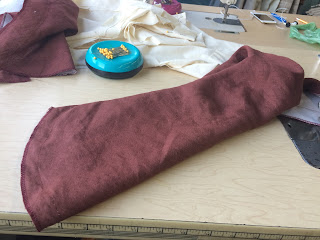Whew, life got busy once I was working as a stitcher full-time for a local regional theatre, and I didn't post anything about my most recent project! Let's take a looksey:
For a trip to the Texas Renaissance Faire in November, I decided to quickly draft and put together a simple cotehardie in the style of the French 1350's. Nothing says fashionable like the Plague Years: while the Bubonic was sweeping Europe, fashions temporarily took a turn for the risque and extremely fitted, wide-necked dresses briefly became popular- some were even worn off-the-shoulder.
This fabulous lady is wearing her tight-fitting cotehardie under a fur-trimmed surcoat- note the row of buttons at center front
More inspiration
This classy dame is wearing a wide belt low on her hips, and representing her heraldic colours with her parti-coloured gown.
My sketch, showing the basic shape and button placement
The fabric on the left is the 100% linen that I found on sale at JoAnn's, and the red is was an inspiration for the colour. I bought the sandy beige fabric, a few bottles of RIT dye, and went to work
Laying out the yardage to press and roll- it turned out very close to what I was picturing, a warm rusty red-brown.
The sleeves were cut from one piece on the bias, so they fit nice and snug. They have gussets drafted into the design, which were inspired by an extant dress from the 14th century found preserved in a bog in Greenland
This is what my pattern pieces looked like- long and curvy! I drafted the body in four pieces, with the center front being mostly on-grain with just a few minor curves.
My mannequin usually fits on a box, but I had temporarily misplaced it so here she is swimming in hem allowance. For the picture the front opening is pinned shut and the triangular godet is pinned at the hip
Sleeves basted in, checking on how I liked the button spacing. Here you can see just how wide the neckline is- the sleeves perch right on the shoulder points.
Historical research for round buttons in the medieval period
Almost done! The dress is hemmed, the godets are sewn (that had to be done twice, as originally I had placed them a little too high and there was more bulk around my hips than I wanted).
The neckline and sleeves are finished with piping, which there is Almost Certainly historical research for (though it's a little hard to tell in paintings whether it's piping or trim in the paintings)
My fabric buttons! They are made out of small squares of fabric folded in on themselves over and over until they become tight little balls.
That's it for the progress photos! This dress came together, start to finish, from dyeing to pattern drafting to sewing to detail work, in a total of three weeks. I was working full-time during the day during that period, so my fingers were awfully sore from sewing for 8 hours, then coming home to sew some more! The last three days days before our trip I stayed up sewing until 3 am, and on the last day I pulled and all-nighter, just barely finishing the buttons before it was time to head to the airport.
Tomorrow I'm enlisting my sister to take photos, so those will be up hopefully before too long. Now I'm in the design stages for my next historical project, a Venetian gown in the style of the 1560s.



















